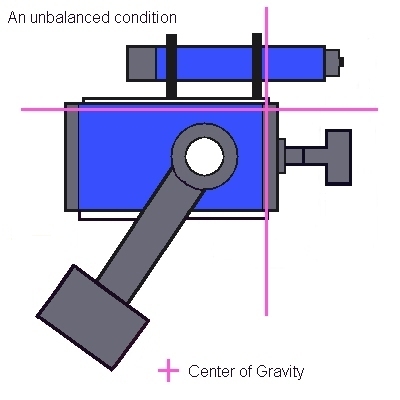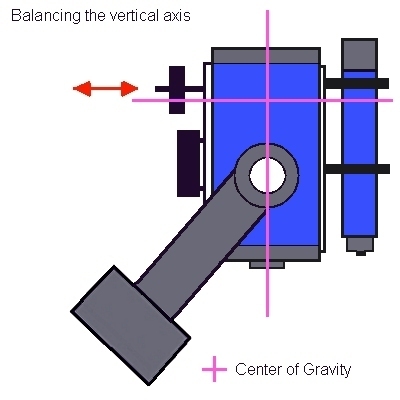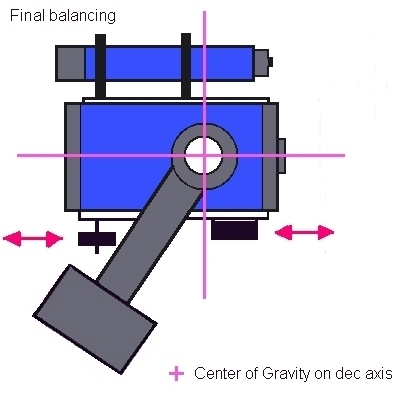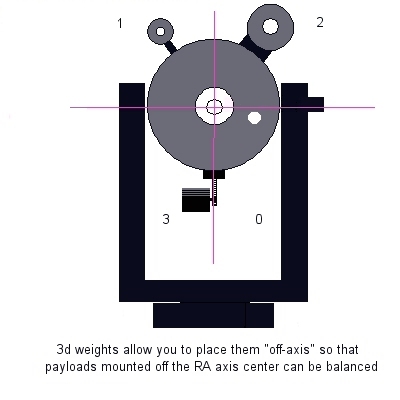Balancing an SCT Balancing takes a little practice. If you have regular accessories that you use all the time, it's recomended that you balance your scope when you have time indoors, then mark the locations of your accessories and weights to speed up setup time in the field. Note that the images show two weights - you may not need two weights, I just show them to illustrate what a 2d weight system is capable of. Out of Balance This first image shows an unbalanced scope. A heavy CCD camera and a guide scope are attached and have put the scope out of balance. This scope is tail heavy and top heavy and has no counter balances. The center of gravity is high and to the rear, which will cause the OTA to fall towards the rear in all angles of use.
Everyone has a different method of balancing. Some people balance horizontally first, then vertically. Others will just play with the weights until the scope feels balanced in all situations. I prefer to balance vertically first, then horizontally. What accessories you have, if they're moveable, and how often you'll need to change your accessories and weights will determine the best method for you. Vertical axis balance I raise the OTA to point at the zenith, then lock the declination axis. I move my 2d weight away from or towards the OTA to counterbalance accessories on the top rail. I'll loosen the declination clutch and see which direction has more weight, and move the weights to adjust. When done, the OTA will neither fall one way more than the other direction. Note in the image below, the vertical axis is balanced - the center of the weight is over the declination axis. It is still unbalanced horizontally with too much weight towards the corrector plate.
Normally, you'll find that the same amount of counterbalance weight as your accessories will suffice to balance the whole system properly. Make sure you take into account the rails, dovetails and any heavy 2" EP's you may be using. Horizontal axis balance Once the scope is balanced vertically, I move the OTA to horizontal and slide the weights along the OTA to achieve a balanced condition. You may need to slide your top mounted accessories (like a guide scope) to find a center. In the image below, the center of gravity is now both centered vertically and horizontally over the declination axis.
When the scope is balanced in both axis, it should move with the declination clutch unlocked very easily in all directions, without "falling" in any particular direction. Practice with your scope using all the accessories you plan to use and don't forget the dew shield. Even though they don't weigh much (barring Meade's aluminum shield) they still add weight to front end of your OTA. 3d off-axis weights and payloads Most accessories are mounted on a central rail along the top or bottom center of the OTA. There are occasions that arise when they must be mounted elsewhere - for accessibility or to make room for other payloads. Off-axis (or "3d") weights are needed when accessories are mounted on the OTA off the center of the RA axis. Finderscopes, Telrads and smaller accessories need not be worried about for most situations. Heavier refractors or camera equipment mounted far off the RA axis requires that "off-axis" balancing be utilized.
These weightsets are designed so that off-axis payloads can be compensated for. They allow you to move the weight in three directions (hence "3d") - along the OTA from front to rear, away from or closer to the OTA, and off-axis. Off-axis payloads can stress the RA gears and bearings, or even unload the RA gears in certain positions. They can also add uneven loading to the dec bearings by adding uneven weight along the dec axis. If you have a heavy, off-axis payload, a good 3d weightset is required to prevent wear on the gears and bearings, and to prevent backlash (unloading) of the RA drive at certain altitudes and azimuths. A second alternative would be to mount your 2d weightset off-axis using the additional accessory screws on the OTA. Not the preferred method, since removal of off-axis payloads would require the weightset to be removed and remounted as well. || Back
to Contents || Wedge
adapter || Focuser
|| Azimuth
adjuster || Weight
Set || Dovetail
||
|



